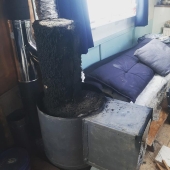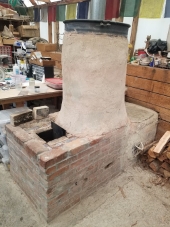
 1
1









For all your Montana Masonry Heater parts (also known as) Rocket Mass heater parts.
Visit me at
dragontechrmh.com Once you go brick you will never go back!
 1
1




Silence is Golden
For all your RMH needs:
dragontechrmh.com




thomas rubino wrote:Hi Fraser;
So, you are losing heat without cob around the transfer pipe. Definitely cover it up.
I plan to do this tomorrow
What temperatures are you getting on your barrel?
Around 245 degrees c. Sometimes hotter but thats average.
What temperature is the exhaust pipe where it heads outside?
48.8 degrees c.
I know you made a few changes recently. Like removing the extra superwool around your riser.
Have you made other changes?
One thing. The pipe that conects the heater to the bench is 20cm deeper.
Where your heat enters half barrels does the pipe just dump into the bell?
No
Or have you piped it further into the bench?
Its inserted about 1 metre inside the bell/bench
Some builds, the end of the bench doesn't get warm enough and to correct that they pipe the heat to the far end and let it stratify from there.
It takes a long time to build heat in brick and cob.
EDIT) And meanwhile all the steel is absorbing and the quickly radiating that heat into the room.
I can see this being the problem. It heats up a badly insulted boat in roughly 10minuted. So all the radiant heat fom the barrel is effective but the bench wont heat. I think i understand what the problem is
You could try wrapping the lower part of your barrel with superwool and see if that helps.
I was planning to superwool the bottom and then cob over the bottom and some of the barrel/bell
 1
1




Gerry Parent wrote:Hi Fraser,
Has the fuel or method of burning changed? Is it dry and the same type of wood? Are you loading it and then restricting the air inlet so it burns slower?
A certain amount of moisture and blackness is normal. Its only when either forms very quickly or in large amounts that is indicating that something is wrong.
To me, the moisture is forming because the dew point of the exhaust gases are too low. The blackness should only collect during start ups or temporarily when reloaded.








 1
1









 1
1














|
I think he's gonna try to grab my monkey. Do we have a monkey outfit for this tiny ad?
Rocket Mass Heater Resources Wiki
https://permies.com/w/rmh-resources
|






